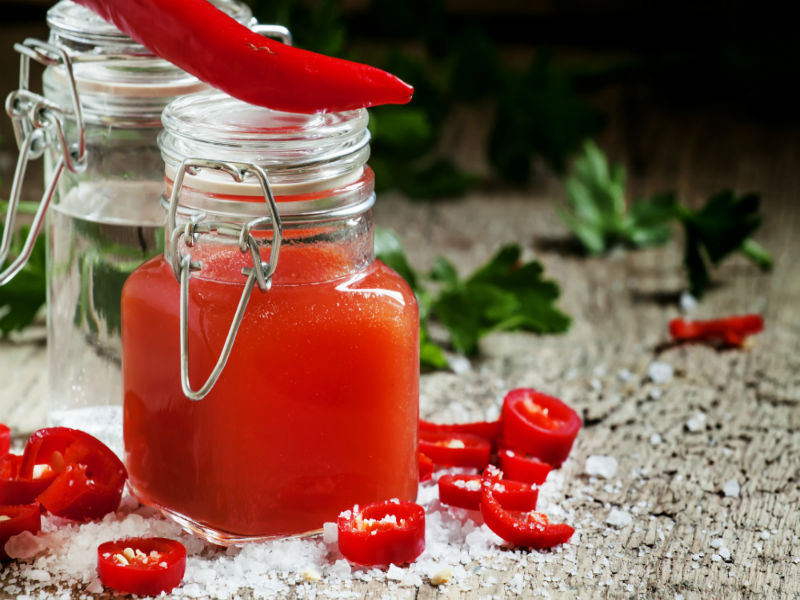A Comprehensive Guide to Types of Chili Sauce
Introduction:
Chili sauce, known for its spicy and flavorful taste, has become a popular condiment enjoyed globally. With its origins in various regions around the world, chili sauces come in diverse flavors, heat levels, and ingredient combinations. In this article, we will explore and categorize some of the most well-known types of chili sauces, providing a guide that will help spice enthusiasts navigate the variety of options available.
1. Sriracha Sauce:
Originating from Thailand, Sriracha sauce is one of the most widely recognized chili sauces worldwide. Made primarily from red chili peppers, vinegar, garlic, sugar, and salt, Sriracha is known for its distinct tanginess coupled with a moderate heat level. Its versatility makes it a popular choice for various dishes, including dipping sauces, marinades, salad dressings, and even pizza toppings.
2. Tabasco Sauce:
Tabasco sauce is an iconic chili sauce hailing from Avery Island, Louisiana. Made from tabasco peppers, distilled vinegar, and salt, this sauce is characterized by its vibrant red color and intense heat. Tabasco sauce has a sharp, tangy flavor that adds a spicy kick to dishes such as soups, stews, and Bloody Mary cocktails.
3. Sambal Oelek:
Sambal Oelek is a traditional Indonesian chili paste that is revered for its simplicity and versatility. Made from ground chili peppers, salt, and vinegar, it offers bold, fiery flavors without the addition of many other ingredients. Sambal Oelek is used as a base in many Indonesian dishes, but it can also be used as a condiment, marinade, or dipping sauce.
4. Harissa:

Originating from North Africa, particularly Tunisia, Harissa is a chili paste that delivers a robust and complex flavor profile. Made from a blend of roasted red peppers, chili peppers, spices such as cumin and coriander, garlic, and olive oil, Harissa imparts a smoky, earthy taste with a moderate level of heat. It is commonly used in dishes such as couscous, tagines, and grilled meats, adding depth and warmth to the flavors.
5. Korean Gochujang:
Gochujang is a staple in Korean cuisine and a fundamental ingredient in many traditional dishes. This fermented chili paste is made from red chili peppers, glutinous rice, fermented soybeans, and salt. Gochujang offers a unique combination of sweetness, umami, and spiciness, making it a versatile ingredient that enhances the flavors of stews, soups, marinades, and even savory pancakes.
6. Peri-Peri Sauce:
Originating from Portugal but gaining popularity in various African countries, peri-peri sauce is known for its fiery and tangy taste. It is made primarily from African bird’s eye chili peppers (peri-peri peppers), along with onion, garlic, lemon juice, and a variety of spices. This sauce is frequently used as a marinade for chicken, beef, or seafood, delivering a vibrant and spicy flavor.
7. Louisiana Hot Sauce:
Louisiana Hot Sauce is a spicy condiment that embodies the flavors of the American South. Made from aged and distilled red peppers, vinegar, and salt, this sauce offers a medium heat level with a tangy, peppery taste. Louisiana Hot Sauce is a popular addition to fried foods, sandwiches, and Creole dishes, adding an authentic Southern kick.
8. Mexican Salsa:
Salsa is a common chili sauce found in Mexican cuisine, available in various types such as salsa roja, salsa verde, or pico de gallo. These sauces are typically made with ripe tomatoes, chili peppers, onions, cilantro, lime juice, and other ingredients based on regional preferences. Salsas vary greatly in terms of heat levels, flavors, and textures, ranging from mild and refreshing to smoky and fiery.
9. Green Chilli Sauce:
Green chili sauce is a vibrant and tangy sauce made from green chili peppers, vinegar, garlic, lime juice, and various herbs and spices. It offers a fresh and zesty taste, and its versatility makes it a perfect complement to salads, sandwiches, grilled vegetables, and seafood. Green chili sauce is often milder in heat compared to its red counterparts.

Conclusion:
Chili sauces come in an extensive range of flavors, heat levels, and cultural variations. From the smooth tanginess of Sriracha and the fiery bite of Tabasco to the deep flavors of Harissa and Gochujang, chili sauces have become an indispensable component of cuisines worldwide. Whether you prefer the bold spice of Indonesian Sambal Oelek or the smoky earthiness of Tunisian Harissa, there is a chili sauce to suit every palate and culinary adventure. So, next time you are looking to add a kick to your dishes, explore the wide array of chili sauces available and savor the taste of spice!Types of Chili Sauce: Spicing Up the Business Market
1. The Rising Popularity of Chili Sauce:
Chili sauce, once considered a niche condiment, has experienced a surge in popularity in recent years. Its versatile flavor profile and the growing interest in global cuisines have contributed to its widespread appeal. As a result, the chili sauce market has expanded significantly, with businesses capitalizing on the demand for different types of chili sauces catering to various taste preferences.
2. Understanding Consumer Preferences:
In today’s diversified market, it is crucial for businesses to understand the different types of chili sauces and their target consumer base. Conducting market research and analyzing consumer preferences will help businesses identify the most sought-after flavors, heat levels, and packaging options. This knowledge will guide their product development and marketing strategies to appeal to the widest possible audience.
3. Targeting Specific Culinary Trends:
Chili sauces can align with specific culinary trends to attract modern food enthusiasts. For instance, businesses can develop plant-based chili sauces to cater to the growing demand for vegan and vegetarian options. Alternatively, organic and all-natural chili sauces can appeal to health-conscious consumers who prioritize clean ingredients. By aligning with current culinary trends, businesses can expand their market reach and attract a wider customer base.
4. Crafting Signature Flavor Profiles:
To succeed in the competitive chili sauce market, businesses should focus on developing unique and signature flavor profiles. This can be achieved by experimenting with different combinations of chili peppers, spices, herbs, and other ingredients to create distinct taste experiences. By offering a diverse range of flavors, businesses can cater to diverse palates and provide options that suit various culinary preferences.
5. Catering to Heat Levels:

Heat level is a crucial factor for chili sauce consumers. Businesses should offer options ranging from mild to extra hot to cater to individuals with varying preferences for spiciness. Clearly labeling heat levels on the packaging and providing product descriptions will allow customers to make informed choices and enhance their overall experience with the chili sauces.
6. Customization and Personalization:
To establish a loyal customer base, businesses can offer customization and personalization options for chili sauce products. This could include allowing customers to choose their preferred heat level, flavor intensity, or even create their own unique blend of ingredients. Customization creates a sense of ownership and allows consumers to tailor the product to their specific tastes, contributing to enhanced brand loyalty.
7. Packaging and Branding:
Effective packaging and branding play a significant role in attracting customers and differentiating chili sauce products in a crowded market. Attention-grabbing labels, clear descriptions of flavors and heat levels, and appealing packaging designs can significantly impact consumer purchasing decisions. Consistent branding across all marketing platforms will also help businesses establish a recognizable presence in the market.
8. Partnering with Restaurants and Food Service Providers:
Collaborating with restaurants and food service providers can be a strategic move for chili sauce businesses. By offering their products as condiments or incorporating them into recipes, businesses can expand their reach and gain exposure to larger audiences. This partnership not only benefits the businesses directly but also provides additional value to customers through enhanced dining experiences.
9. Online Presence and E-commerce:
In today’s digital era, having a strong online presence and e-commerce platform is essential for businesses in any industry. Chili sauce businesses should invest in creating user-friendly websites, engaging social media accounts, and e-commerce capabilities to reach a wider audience and drive online sales. Additionally, offering exclusive online promotions and discounts can attract new customers and encourage brand loyalty.
10. Introducing Limited Editions and Seasonal Offerings:
To create a sense of excitement and encourage repeat purchases, businesses can introduce limited edition chili sauces or seasonal offerings. These limited-time products can include unique flavors, collaborations with renowned chefs, or themed packaging tied to special events or holidays. By regularly introducing new and exclusive products, businesses can keep customers engaged and maintain a competitive edge in the market.

Conclusion:
The chili sauce market continues to evolve and expand, driven by consumer demand for diverse flavors and heat levels. Businesses in the chili sauce industry can set themselves apart by conducting market research, understanding consumer preferences, and adapting their offerings to align with current culinary trends. By focusing on signature flavor profiles, customization, effective packaging, strategic partnerships, and a strong online presence, businesses can seize the opportunity to thrive in this dynamic market. By continually innovating and engaging with consumers, chili sauce businesses can establish themselves as leaders in the industry, capturing the attention and taste buds of spice enthusiasts worldwide.









